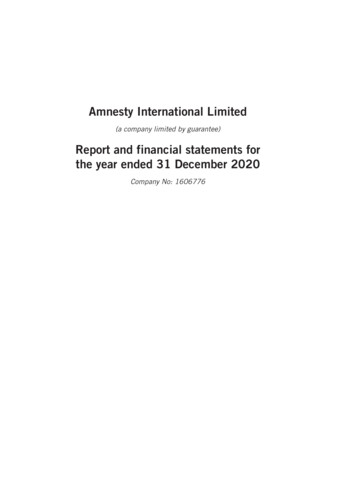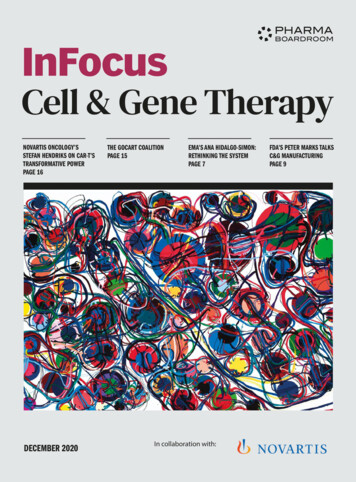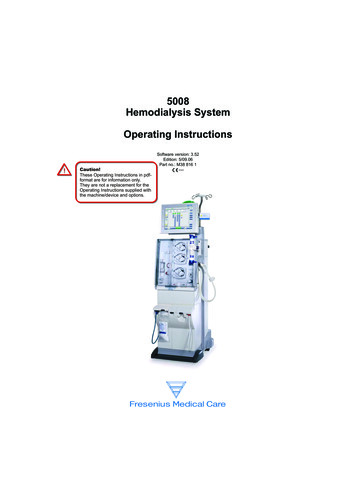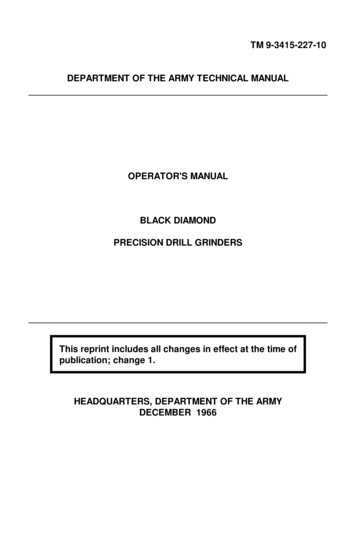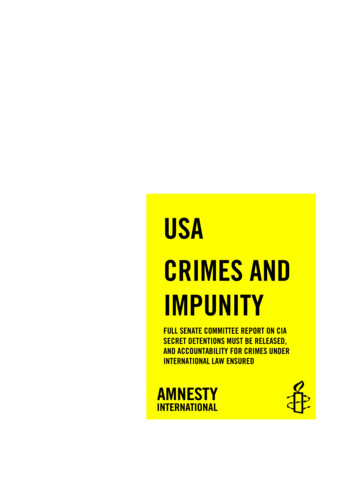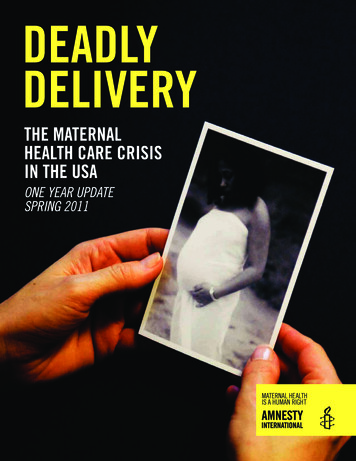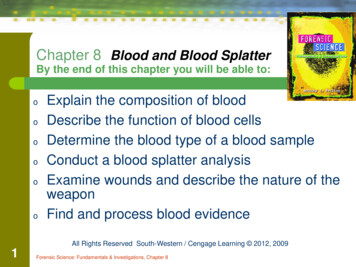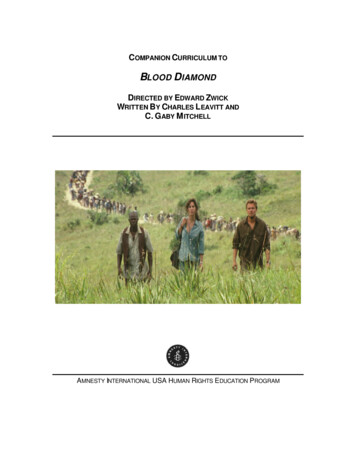
Transcription
COMPANION CURRICULUM TOBLOOD DIAMONDDIRECTED BY EDWARD ZWICKWRITTEN BY CHARLES LEAVITT ANDC. GABY M ITCHELLAMNESTY INTERNATIONAL USA HUMAN RIGHTS EDUCATION PROGRAM
TABLE OF CONTENTSIntroductionFrom the Director . 1From the Editor . 2Movie Discussion Guide . 3Lesson OnePersonal and Collective Responsibility . 4Handout 1.1: Blood Diamond Character ListHandout 1.2: Personal Responsibility DiagramLesson TwoNatural Resource Exploitation and Conflict . 14Case Studies: Cambodia Colombia Cote D’Ivoire Democratic Republic of the Congo NigeriaLesson ThreeCorporate Social Responsibility and Accountability . 36Handout 3.1: Corporate Social Responsibility QuizCase Study: Conflict Diamonds: Cote D’IvoireHandout 3.2: Understanding the Kimberley ProcessAppendices 50Appendix A: Further StudyAppendix B: Glossary of TermsAppendix C: Feedback Form
INTRODUCTIONEDWARD ZWICKFROM THE D IRECTORWhen I first read about Sierra Leone, I was shocked. I’d read books about the colonial“scramble for Africa,” about the exploitation of its ivory, rubber and gold, but to learn thehistory of diamonds was to learn the story of Africa all over again.In certain ways the movie we’ve made is very conventional, an action drama about threepeople whose lives are forever changed by the discovery of a single rough stone. But becausethe story takes place in such a charged political context it is also an opportunity to evoke thekind of provocative images and complex issues seldom treated in Hollywood films. It’s alwaysbeen my belief that entertainment and ideas need not be mutually exclusive, and that politicalawareness can be raised as much by narrative as by rhetoric.If a single piece of work was capable of bringing about immediate change, then so many wellintentioned films over the years would have long ago solved the world’s problems. But raisingconsciousness is a distance event, not a sprint. It’s important to remember that 150 years agoin this country it was entirely acceptable for a man to own another man. Twenty years agopeople thought nothing of drinking and driving. Five years ago you could smoke in restaurantsand on airplanes. These are remarkable paradigm shifts, but they only came about by anumber of people willing to hold up a mirror, unflattering at times, in order to show the world toitself. As a filmmaker, all I can do is to add my voice to the chorus. Eventually the aggregateeffect of movies, songs, documentaries, and editorials are compounded until it reaches a kindof tipping point. And change happens.The United States purchases about nine billion dollars’ worth of diamonds every year, morethan two-thirds of the world's sales. If its consumers insist that each stone be accompaniedby a verifiable warranty, it’s going to have a very powerful effect. This is one of those raresituations in which an individual can become pro-active by virtue of nothing more thaneducating himself. We simply have to take responsibility for our consumerism.I have nothing against diamonds (or rubies or emeralds or sapphires). Gems are beautifuland desirable. To buy or not to buy is an individual decision. But it has to be an informeddecision. I do object when their acquisition is complicit in the debasement of children, or thedestruction of a country. I find it unconscionable that the resources of the third world beexploited for the sake of our vanity, and above all that billions of dollars of corporate profit arebuilt on the backs of workers paid a dollar a day. The story of Sierra Leone is not unique.My hope is that in telling a story like this, it might help prevent it from happening again.- Edward Zwick 2006
FROM THE EDITORINTRODUCTIONHOW TO U SETHIS G UIDEThe companion guide for Blood Diamond provides activities and lessons designed to engagelearners in discussion of issues which seem difficult and complex, such as the connectionbetween natural resource exploitation and regional conflict. Designed to be as comprehensiveand informative as possible, this guide can be used in its entirety as an in-depth unit of studyor individual lessons can stand alone as learning extensions after watching the film. Analternative to showing the whole film is using clips that correlate with individual lessons. Formore tips on using film in educational settings, please go to our nal resources, such as interactive maps, international documents, fact sheets, and linksto actions and reports can also be found at our website.Prior to showing the film, educators should prepare learners by discussing key topicsaddressed in the film. For example, educators could review the history of Sierra Leone orreview a map of the region. After viewing the film, or clips from the film, give students theopportunity to share their reactions and questions. Use the movie discussion guide to facilitatecritical discussion of the film.Use the glossary provided at the end of this guide to assist students with understandingconcepts, terms, and organizations that may be unfamiliar to them. Lesson 2, NaturalResource Conflicts, is intended as an additional resource, complete with maps and casestudies, to help students understand the connection between natural resource exploitation andregional conflict.For additional reports and studies, or for more information about how to take action on theissue of conflict diamonds, please visit the following websites:Amnesty International: Blood Diamond – http://www.amnestyusa.org/blooddiamondGlobal Witness: Diamond Campaign – http://www.globalwitness.org/campaigns/diamonds/If you have questions or would like additional support, please contact the Human RightsEducation program of Amnesty International (education@aiusa.org) or visit our website.* Please take the time to fill out the feedback form found at the end of this guide or online RICULUMOBJECTIVESTARGETAUDIENCEüTo introduce discussion and analysis of the social and political changes in SierraLeone in 1999, as depicted in the film Blood DiamondüTo analyze personal motivations for our actions and the effects our actions have onothersüTo examine the connection between natural resource exploitation and regional conflictüTo engage students in discussion of corporate social responsibility and consumeractionThis guide is designed primarily for high school and college age students, as well as adultlearners. It can be used in social and international studies classes, history classes, or as astand-alone learning opportunity. It can also be used in community settings, such as filmfestivals, house party screenings, or group meetings.
MOVIE D ISCUSSION GUIDEINTRODUCTIONDISCUSSIONQUESTIONS1.What human rights issues were illustrated in the film? What international laws are inplace to stop or prevent those abuses?2.Do you think the violence depicted in the film is necessary to accurately portray thesituation in Sierra Leone in 1999?3.After the RUF burns Solomon’s village, they chop off the hands of the villagers. Whatis the significance of this action? What does it symbolize?4.The film began and ended in Antwerp, Belgium. How did events in Belgium relate toevents in Sierra Leone?5.Why did Danny Archer become involved in the conflict diamond trade?6.In the beginning of the film, all Danny seems to care about is himself. At the end of thefilm, however, he is willing to die to protect Solomon. What prompted Danny’s changeof heart?7.When Danny talks to Benjamin, the school teacher, Benjamin says that he wants tobelieve all people are basically good, but his experience tells him otherwise. Dannyreplies that people are just people. What do you think he means by this statement?8.At the end of the film, Solomon comes face to face with Captain Poison, the RUFcommander responsible for forcing Solomon into slavery and turning his son, Dia, intoa child soldier. Captain Poison says that Solomon might think he’s the devil, but it isonly because he lives in hell. In what ways is Captain Poison a product of hisenvironment and in what ways is he a product of his choices?9.For each character in the film, diamonds represent a different idea or symbol. CaptainPoison, for example, sees the pink diamond as his ticket to a better life. What dodiamonds represent to each of the characters?10. What tactics does the RUF use to turn children into soldiers?11. All of the characters are changed by events they have witnessed. How does eachcharacter respond to the conflict around him or her?12. Maddy, the journalists and other foreign players, such as aid workers, struggle withreporting what they see, doing their duty, and actually helping individuals in need.They often fall prey to an “us” vs. “them” attitude. How does the film deal with the ideaof “the other”?13. Though the film focuses on the devastation of war, it also deals with reconciliation,rehabilitation, and hope. What are some specific scenes that deal with these topics?How can the country begin to reconcile and recover from the effects of war?* Note to Educators: Please share with us any additional or alternate questions you oryour students posed during the discussion. Use the feedback form found at the end of thiscurriculum guide or online at: www.amnestyusa.org/education
PERSONAL AND C OLLECTIVE RESPONSIBILITYLESSON 1QUESTIONHow can an individual or community take personal or collective responsibility in a societyfractured and ravaged by war?TIMEOne ClassOVERVIEWIn the movie Blood Diamond, the characters’ choices and actions are limited by outside eventssuch as the diamond trade, the fight for independence, the corruption of the government inSierra Leone, the decisions of the United Nations, and the complexities of internationalpolitics. For example, Solomon is part of a society that has become so fractured by war thathis community’s ability to join together to effect change is severely limited. How, then, can hiscommunity begin to find a voice? How can fractured societies form a sense of community?How can his individual choices and actions, as a fisherman in a small village, impact the largerforces that are arrayed against him in order to create meaningful change? This lesson isdesigned to analyze the choices and actions of the characters in the film in order to betterunderstand the ways in which their choices, however limited, impact their society and theactions of other characters or groups. Once students have analyzed the ways in which evenlimited actions can effect change, they will complete a mapping exercise designed to helpthem think through the ways that they can personally take effective action on an issue of theirchoosing.OBJECTIVESStudents will be able to:- Demonstrate knowledge of external factors which influence personal action- Develop a causal diagram which highlights the causes and effects of a character’s actions- Analyze the choices available to an individual in a conflict environment and the ways inwhich those choices can influence the individual’s community or the external factors in theconflict- Discuss the issues of personal and collective responsibility in a conflict environment- Create a causal diagram of an issue of their choosing and discuss ways in which they couldtake personal or collective responsibility to create effective changePREPARATIONResources and Materials: Handout 1.1 – Blood Diamond Character List Handout 1.2 – Personal Responsibility DiagramPROCEDURE1. In the film, Danny accuses Maddy of writing about the conflict in Sierra Leone without takingany meaningful action to help others or stop the conflict. His comment raises the issue of thescope of Maddy’s personal ability and responsibility to take action. Her actions, though limitedby the information available to her, the choices of those around her, and her role as ajournalist, were still meaningful because her articles contributed to a growing awareness of theconflict in Sierra Leone. Combined with the actions of others, her work helped to change thedirection of the conflict in Sierra Leone.Consider the following questions in a class discussion. Students should use specific examplesfrom the film to support their answers.1) Think of specific actions that a person could take to create change in a conflictenvironment.2) If a person’s freedom of choice and movement is limited, is their mandate to takepersonal responsibility lessened?6
LESSON 1PERSONAL AND C OLLECTIVE RESPONSIBILITY3) In a conflict environment, traditional ideas of community are often shattered, limiting theability of a group to take collective action. What are the responsibilities of a community ina conflict environment? What are some ways that a community can take collective actionin a conflict environment?4) In what ways can an individual take action to help foster a renewed sense ofcommunity? How does a sense of community enable more effective action?2. Before beginning a conversation about personal responsibility, one must first examine thechoices available to an individual within a given situation. Examining the choices availableenables one to determine the types of personal actions that are possible and the types ofactions that will best effect change. Handout 1.2 uses a simplified variation of a causal loopdiagram, often used to chart the effectiveness of foreign policy initiatives, map complexsystems and illustrate the ways that factors within a system interact and loop back to impactthe overall situation. After examining the causal diagram, it becomes apparent that the effectsof a person’s choices often work over time to influence the external limiting factors, therebymaking change possible and creating additional choices and pathways for the individual andhis or her community.For example, Danny gives Maddy a list of his contacts within the diamond smuggling trade inexchange for her help finding Solomon’s family at the UN refugee camp. Danny’s choice toreveal his sources created the opportunity for Maddy to publish an expos é about conflictdiamonds, which in turn led to more stringent UN sanctions and the possibility of peace talks.The effect of Danny’s decision, then, looped back to affect the external factor of conflict, whichhad until that point influenced and limited his personal choices and actions.After creating a causal diagram for a character, students can begin to talk about what theresponsibilities of the character are or should be, and what actions the character can take tofulfill his or her responsibilities. Explain the concept of a causal diagram and review theexample on the handout. (See the reference section for further information about causal loopdiagrams.)3. Divide the students into small groups. Assign each group one of the characters ororganizations featured in the film. (See Handout 1.1 for a list of characters and organizations)Each group will analyze the choices that the character made in the film. Following the exampleon Handout 1.2, the students will map the character’s choices, the external limiting factors forthat character, and the effects of the character’s choices on the overall conflict and othercharacters. The students should consider the following questions during group work:1) What were the character’s motivations for his/her actions?2) Does his/her attitude change over the course of the movie? How and why?3) How would you characterize the level of his/her personal responsibility at the outset ofthe film? Did this level change as events unfolded? If so, how and why?4) How were the character’s choices limited/affected by outside events?5) How were the character’s choices limited/affected by his or her role in society?6) How were the character’s choices limited/affected by his or her belief system?7) How were the character’s choices limited/affected by his or her culture?8) What choices were available to him or her?9) How did the character’s choices either open up new paths for other characters or closepaths to other characters?10) How did the character’s individual choices impact the overall conflict in Sierra Leone?How did his or her choices impact other external factors?7
LESSON 1PERSONAL AND C OLLECTIVE RESPONSIBILITY11) Identify two or three attempts by the character to protect human rights in his/hercountry or community. If there were no such attempts, why not?12) What further actions could the character have taken to create more effective change?4. After the students have finished the mapping exercise, each group will give a presentationof its character map. Facilitate a class discussion about the ways that the characters andorganizations interacted to impact the situation in Sierra Leone. Ask for final thoughts aboutthe ways in which people can take personal and collective responsibility and action in aconflict environment.EXTENSIONACTIVITYAsk students to choose one issue that is important to them, whether it be wildlife conservation,sweatshop labor, police brutality, or access to healthcare. Either individually or in groups, thestudents will develop a causal diagram to map the choices available to them, and the ways inwhich they can take personal responsibility on the issue. Students should consider thefollowing questions:1) What are the external factors which affect personal choice on this issue?2) Who are the players involved in this issue? Who has the most power? Who has theleast power? Who are the players in between?3) How does each group affect the other?4) In what ways is each group limited either by ideology, culture, or position? In otherwords, what are the influencing factors?5) What choices are available to each group?6) How can the actions of one group open additional choices and actions for othergroups?7) What actions are currently being taken by each group to address the issue in question?8) Are the actions effective, given the limitations and powers of each group and the waysin which the groups interact?9) What actions could increase the effectiveness of the movement?10) How would those actions affect the other groups?11) What choices could the individual make to more effectively create change on theissue?12) How can individuals work together in community to address the issue in question?After the projects are completed, the students will present the results of the project to theclass and engage in a class discussion of the findings.R ESOURCESHow to Develop Causal Loop TMC 04.htmCausal Loop Diagram Example: Research Initiative to Understand and Model 1.html(Use the link to access the paper, and then download the PDF version to view diagrams)8
BLOOD DIAMOND CHARACTER LISTHANDOUT 1.1CHARACTERS ANDINFLUENTIALORGANIZATIONSv Danny Archer – Leonardo DiCapriov Maddy Bowen - Jennifer Connellyv Solomon Vandy – Djimon Hounsouv Dia Vandy (Solomon’s Son) – Kagiso Kuypersv Jassie (Solomon’s Wife) – Benu Mabhenav Benjamin (School Teacher) – Basil Wallacev Captain Poison (RUF commander) – Davie Harewoodv Cordell Brown (Ransacked Archer’s apartment) – Antony Colemanv The Colonel (Archer’s mercenary boss) – Arnold Vosloov Ambassador Walker – Stephen Collinsv Van de Kaap (Head of diamond company) – Marius Weyerv Government of Sierra Leonev Diamond Industryv Government of Belgiumv Government of Liberiav United States Governmentv The United Nationsv Aid organizationsv The RUFv Consumerv Activist9
HANDOUT 1.2PERSONAL R ESPONSIBILITY DIAGRAMIntroductionAt first glance, the lives of the characters in the film seem to be dictated by forces that areoutside their control. It is difficult to talk about issues of personal or collective responsibilitywhen the entire community is fractured and ravaged by war. How, then, can an individual in aconflict situation take personal responsibility to prevent human rights abuses? How can anindividual help to heal a broken community so that the community can take action? In order tobegin to answer these questions, one needs to understand the external forces whichlimit/affect the choices available to the individual. Then, one must examine how individualchoices or actions can relate back to the larger external forces to create change. Causaldiagrams, such as the simplified version below, help to map complex systems and guidethinking about the ways in which factors within a system interact to create change. Directionsfor the diagram use Benjamin as an example, and include a completed causal diagram forBenjamin. Use the directions and the blank causal diagram to map a character from the film.* Note – The diagram does not visually represent the ways in which Benjamin’s actions affectother factors on the diagram or other characters.DIRECTIONS& EXAMPLE OFBENJAMIN (THESCHOOLTEACHER)1) Begin the mapping process by thinking of at least four external, or limiting, factorsthat influence the individual’s action.External Factors Affecting Benjamina) War in Sierra Leoneb) United Nationsc) Diamond Industryd) Child Soldiers2) Think of at least two issues that influence these external or limiting factors.Influencing Factors Affecting External Factorsa) War in Sierra Leone – Affected by East/West tensions and the rebel groups’ strugglefor power after the withdraw of colonial powersb) United Nations – Affected by the needs and policies of multinational corporations andinternational politicsc) Diamond Industry – Affected by UN sanctions and consumer/market economyd) Child Soldiers – Affected by lack of troops for rebel forces and ease of obtaining smallarms and training young children3) Brainstorm at least two ways in which each of the external, or limiting, factors affectthe character.Effects of External Factors on Benjamina) War in Sierra Leone – Results in fractured society; Forces Benjamin to begin arehabilitative school for child soldiers in hidingb) United Nations – Results in the introduction of aid organizations, such as UNICEF,which support the foundation of rehabilitative schools for child soldiers; UN sanctionsand peace agreements lead to temporary cease fires, which lead to the release ofsome child soldiers from military servicec) Diamond Industry – Buying of conflict diamonds leads to extended conflict and naturalresource exploitationd) Child Soldiers – Training of child soldiers leads to the formation of a generation ofchildren who lack education or skills; Training child soldiers leads to the increasedprobability that future generations will resort to violence in an attempt to solve issues.10
PERSONAL R ESPONSIBILITY DIAGRAMHANDOUT 1.24) Personal beliefs, cultural beliefs, and religious and national ideologies also influenceindividual action. List at least two beliefs that influence the action of the character.Personal and/or Cultural Beliefs of Benjamina) Believes nation can be saved/ Strong sense of national identityb) Believes in rehabilitationc) Believes people are inherently goodd) Believes in power of education5) List at least four choices that the character makes.Actions ora)b)c)d)Choices of BenjaminStays in AfricaFounds rehabilitative school for child soldiersActively helps child soldiers escape from military serviceStops car to talk to child soldiers who have guns6) List at least one result, whether positive or negative, of the action/choice.Result of Actions or Choices Made by Benjamina) His choice to stay in Africa resulted in the possibility of community and is an exampleof courage for others.b) His choice to found a rehabilitative school resulted in a sense of community for thechild soldiers, helped to break the cycle of violence, and gave both the child soldiersand other members of the community hope in the future.c) His choice to actively help child soldiers escape resulted in a risk to his personalsafety, as well as a second chance for the children and a sense of hope and couragefor the community.d) His choice to stop the car and attempt to help the child soldiers flowed from his beliefin the basic goodness of others and his belief that people can be rehabilitated.Though his choice led to his shooting, it also contributed to the evolution of bothMaddy and Danny’s characters. In the end, his actions helped make their choicespossible.11
PERSONAL R ESPONSIBILITY DIAGRAMHANDOUT 1.2Personal Responsibility DiagramInfluencing FactorsEast/WestIdeologies ColonialismStruggle forIndependenceWar in SierraLeone1. FracturedSociety2. Forced to HideLocation ofSchoolMultinationalCorporationsUnitedNations1. Presenceof Aid Orgs.2. lFactorsConsumerDemandDiamondIndustry1. ProlongedConflict2. NaturalResourceExploitationResultsLack ofTroopsEase ofObtainingSmall ArmsChild Soldiers1. Increasedprobability offuture violence2. Generationlacking edu.BenjaminBenjaminNationalIdentityFounds School forChild SoldiersBelief inRehabilitationBeliefsSaves ChildSoldiersActionsBreaks theCycle ofViolencePersonal RiskContributes toSense ofCommunityOpportunity foredu. &reintegration incommunityResults12Believes Peopleare InherentlyGoodBelieves in thePower ofEducationStops to talk tochild soldiersStays in AfricaThe childrenshoot himPossibility ofCommunityImpacts Danny& Maddy’sDecisionsExample ofcourage forothers
HANDOUT 1.2PERSONAL R ESPONSIBILITY DIAGRAMPersonal Responsibility DiagramInfluencing 13
LESSON 2INTRODUCTIONW ORLD MAPOBJECTIVENATURALR ESOURCECONFLICTNATURAL RESOURCE CONFLICTSBlood Diamond reveals the gruesome realities of the role of conflict diamonds in SierraLeone’s recent civil war. Unfortunately, as Edward Zwick mentions in his introduction to thisguide, the story of Sierra Leone is not unique. Armed struggles for access to oil and naturalgas, diamonds and minerals, cocaine, timber, water, and of course land itself, have a longhistory of causing worldwide humanitarian crises. From colonial exploitation to modernconflicts in Africa, Latin America, the Middle East, Southeast Asia, and the former SovietUnion, many lands rich in natural resources have been devastated by war and poverty. Thisparadoxical “resource curse” has generated volumes of study on the links between abundanceof natural resources, poor governance, negative economic growth, war, and human rightsabuses.Lesson 2 provides resources to explore these links. Because of the scope of the materials onnatural resource exploitation, we have created an interactive online map coupled withrepresentative case studies, rather than a comprehensive lesson plan. Each case studyfocuses on a country that has suffered from conflict arising from, or exacerbated by, naturalresource exploitation, and includes a recent historical timeline, discussion questions, andfurther studies section.In contrast to the ideological wars fought during the Cold War, modern conflicts often center onthe struggle to control natural resources such as oil, gemstones, minerals, and timber. Moreand more, the illicit exploitation of resources can be directly linked to violent conflict,environmental disaster, and human rights violations. In the late 1990s alone, the number ofconflicts nearly tripled, leaving millions dead and tens of millions displaced (Porto).In some countries, groups fight for access to oil, minerals, gemstones, or timber in order tofund conflicts originally triggered by other factors such as a struggle for independence orperhaps ethnic or religious tensions. Elsewhere, armed conflict begins as a struggle for theseresources, motivated by either need or greed.“In many instances, resource extraction itself causes conflict,” says Michael Renner ofWorldwatch. “Around the world, the operations of oil, mining, and logging companies arecausing severe tensions with local populations, often indigenous communities. Typically,these operations confiscate land from local people without proper compensation. They causean array of environmental problems by poisoning drinking water, destroying arable land, clearcutting forests, and despoiling hunting and fishing grounds [Meanwhile] the economicbenefits from resource extraction mostly accrue to outsiders: the central government,multinational corporations, and assorted foreign investors.”Wealth in “lootable” resources (high value goods which can easily be traded or sold) does notnecessarily predict war. Conflicts are generally a result of the combined geographic, political,economic, and military factors which weak en governments and their economies, while givingrebels the opportunity to mount insurgency campaigns. Nevertheless, the rising frequencyand devastating human right and environmental consequences of these natural resourceconflicts demands increased awareness and immediate action.Michael Renner. The Anatomy of Resource Wars. Worldwatch Institute: www.worldwatch.orgJoão Porto. Scarcity and Surfeit: The Ecology of Africa’s Conflicts.African Centre for Technology Studies and Institute for Security rfeit/Main.html14
NATURAL RESOURCE CONFLICTSLESSON 2EXTENSIONSOURCESLesson 2 resources can be applied in a wide range of lesson plans and classroom activities.For example, they can be used to spark debates on the causes of regional conflict, to facilitateanalysis of the political, economic, environmental, and human rights impacts of resource wars,to raise awareness about the impact of consumers and corporations, or simply to expanddiscussion on resource wars, their causes, and potential resolutions. Several ideas include: Debate the causes of regional conflicts. Do natural resources cause wars, or merelyprolong them? Consider the colonial legacy in resource exploitation, and the powervacuum that accompanied decolonization, existing ethnic or religious tensions,government corruption and abuse, and the accessibility
film, however, he is willing to die to protect Solomon. What prompted Danny's change of heart? 7. When Danny talks to Benjamin, the school teacher, Benjamin says that he wants to believe all people are basically good, but his experience tells him otherwise. Danny replies that people are just people. What do you think he means by this .
